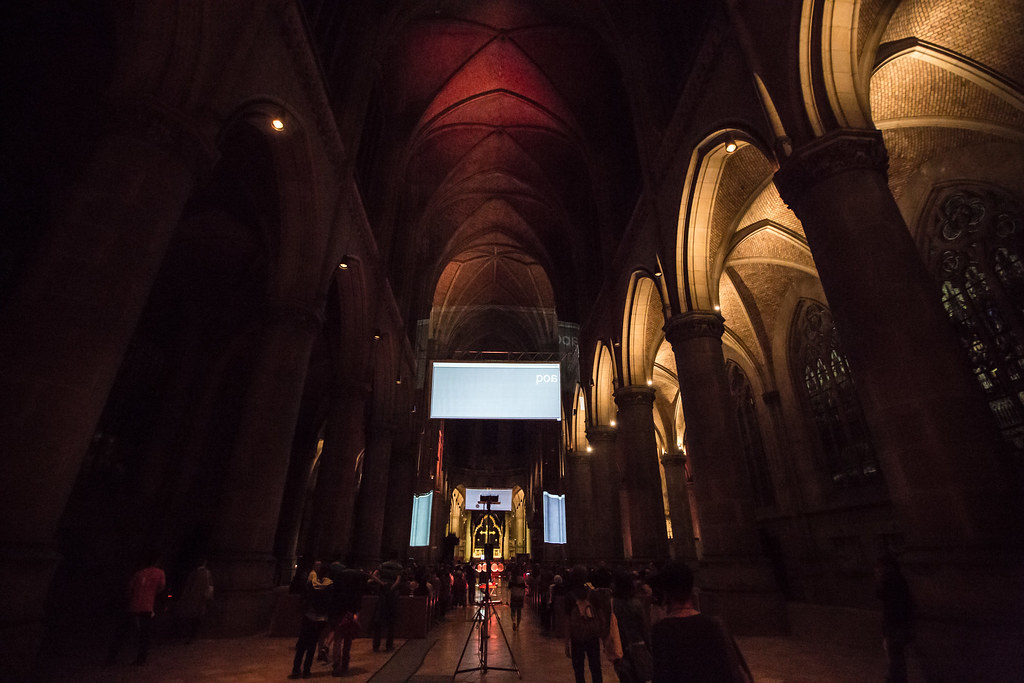Aural Memory Machine at Ars Electronica 2013
Sound installation and concert at Ars Electronica 2013 in the Mariendom Linz.
Admin
September 7, 2013

Sound installation and concert at Ars Electronica 2013 in the Mariendom Linz.

Pic by Florian Voggeneder for Ars Electronica
Soundinstallation Aural Memory Machine: Mariendom, Linz September 7th 2013 12h – 17h und 20h – 22:30h
Performance: Mariendom, Linz September 7th 2013 23h – 24h
Ars Electronica "Total Recall" 2013 & Interview with Wolfgang Dorninger
English text pls. scroll down
Aural-Memory-Machine (AMM) ist eine Sechs-Kanal-Soundinstallation, die vom Publikum im Linzer Mariendom bespielt wird. Das Publikum braucht keine musikalischen oder technischen Vorkenntnisse, sondern gibt lediglich Text mittels Midi-Keyboard ein. Der Text triggert in Echtzeit Field-Recordings (Umweltaufnahmen) aus abgegrenzten Themenkreisen. Das Publikum kann so auf sechs Terminals gleichzeitig diskursiv am Festivalthema teilhaben und eine Raum-Klang-Soundinstallation gestalten.
Das Plugin „text2field-recordings“ ist mit dem Midi-Keyboard die Steuerzentrale von AMM. Die eingegeben Buchstaben werden in Echtzeit auf einem Bildschirm ausgegeben, gleiches gilt auch für den Klang. Field-Recordings sind einzigartige Momentaufnahmen einer akustischen Wirklichkeit. Anders als in der Phonographie, wo das authentische Sammeln von Umweltklängen erklärtes Ziel ist, entsteht bei AMM durch das Hybride eine neue Wirklichkeit. Der Zustand des akustischen Moments im Linzer Mariendom ist nicht reproduzierbar, er ist geprägt von chaotischen Transformationen und der Aufhebung von Zeit. Versucht die Phonographie einer Amnäsie des Klangs entgegen zu wirken, so ist bei AMM gerade dieser Zustand erklärtes Ziel. Akustische Turbulenzen und konstruierte Relationen, ausgehend vom Nullpunkt bis ins Chaotische, verdeutlichen dabei, wie abstrakter Code oder Sprache komplexe Abläufe jeder Art in Gang setzten, steuern oder auch unkontrollierbar machen können. Jede/r einzelne/r MitspielerIn an einem der acht Terminals im Mariendom muss sich laufend die Frage stellen, ob sie/er Text/Code produzieren oder an der Gestaltung eines momentanen akustischen Environments im Dom teilhaben will oder beides. Bei diesem Prozess werden komplexe Fragestellungen unserer Zeit und des Festivalthemas sichtbar.
Nächtliches Konzert
Abschließender Höhepunkt ist ein nächtliches Konzert von Wolfgang Dorninger mit Petra Anlanger (AT), Richard Eigner (AT), Georg Edlinger (AT), Volker Kagerer (AT) und Domorganist Wolfgang Kreuzhuber (AT). Sie benutzen dabei dasselbe Instrumentarium wie das Publikum, spielen aber ein vorgegebenes Repertoire und erweitertem Equipment: ausgewählte Texte aus dem Ars-Electronica-Katalog.
English version:
Aural Memory Machine (AMM) is an six-channel sound installation played by visitors present in Linz’s St. Mary’s Cathedral. No musical training or technical skills are required of audience members; all they have to do is use a midi-keyboard to input texts that, in real time, trigger field recordings having to do with the 2013 Ars Electronica Festival theme. In this way, audience members inputting texts at six terminals can discursively get involved in the theme and simultaneously create a spatial sound installation.
The text2field-recordings plug-in and the midi keyboard comprise the central control unit of AMM. The letters entered are displayed on a screen in real time. The same goes for the sound. Field-recordings are unique “snapshots” of an acoustic reality. In contrast to phonography, the declared aim of which is to put together an authentic collection of ambient sounds, AMM creates a new reality via hybridization. It’s impossible to reproduce the state of the acoustic moment in St. Mary’s Cathedral, which is characterized by chaotic transformations and the suspension of time. Phonography is the attempt to counteract the amnesia of sound, whereas this very state is the declared aim of AMM. Acoustic turbulence and construed relations ranging from absolute zero to utter chaos illustrate how abstract code or language can trigger complex sequences of any sort, control them or make them uncontrollable. Each individual user at one of the terminals in the cathedral must constantly face the question of whether he/she wants to produce text/code, or participate in the design of a momentary acoustic environment on site, or both. Complex questions of our time and issues related to the festival theme are made visible by this process.
Nightly Concert
The culminating highlight is a nightly concert by Wolfgang Fadi Dorninger, Petra Anlanger (AT), Richard Eigner (AT), Georg Edlinger (AT), Volker Kagerer (AT) and Wolfgang Kreuzhuber (AT) and associates, in which they use the same instruments as visitors but play a predetermined repertoire: selected texts from the Ars Electronica Catalog.
Wolfgang Dorninger
"text2field-recordings", 2012/20xx
Soundinstallation, Performance
Länge: changing
Computer
Usine (host)
Plugin text2field-recordings (text -> midi -> sound -> projection of text)
Videobeamer
Soundsystem (best quadro with subwoofer)



